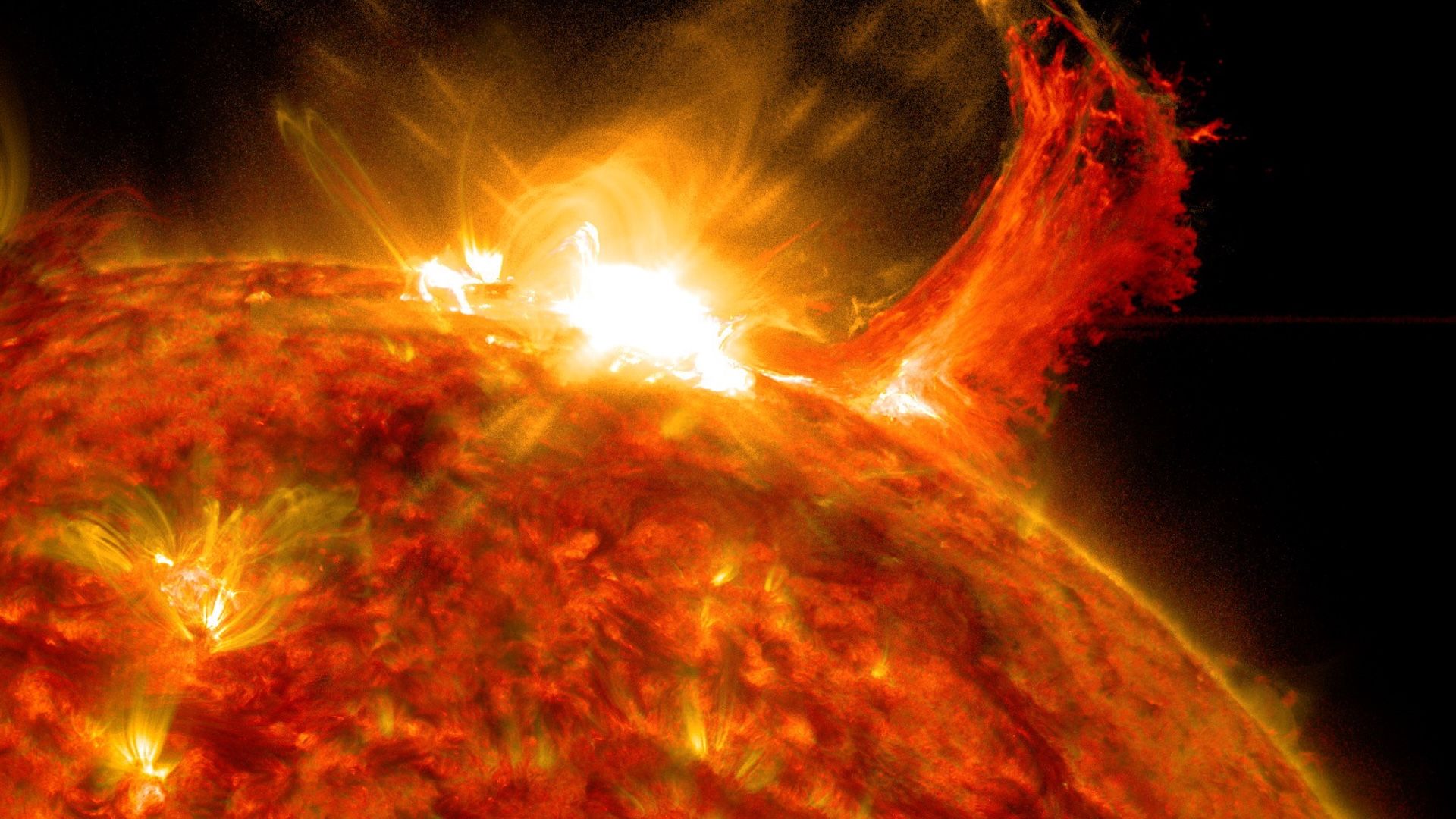For decades, scientists have been trying to answer a burning question — why is the Sun’s outer atmosphere, called the corona, millions of degrees hotter than its surface? The surface temperature of the Sun (the photosphere) is about 5,500°C, but the corona above it blazes at more than one million degrees Celsius.
This strange temperature difference has baffled solar physicists for generations. Logically, the farther away you move from a heat source, the cooler it should get — but the Sun doesn’t follow that rule. Something hidden within its magnetic layers has been transferring energy upward, heating its outer atmosphere far beyond what was expected.
Now, a major discovery may finally provide the missing piece of the puzzle.
For the first time, researchers have directly detected twisting magnetic waves — known as torsional Alfvén waves — moving through the Sun’s outer atmosphere. These waves, which were predicted more than 80 years ago, could explain how energy travels from the Sun’s surface into the corona, helping to keep it superheated.
The findings were made possible by the Daniel K. Inouye Solar Telescope in Hawaii — the largest and most advanced solar telescope on Earth — and were led by Professor Richard Morton from Northumbria University in the United Kingdom.
The Mystery of the Super-Hot Corona
The Sun is made up of several layers, each with distinct physical properties. At its core, nuclear fusion produces enormous amounts of energy, which then radiates outward through the radiative and convective zones. Eventually, this energy reaches the photosphere, the visible “surface” of the Sun, before extending into the chromosphere and corona — the glowing halo seen during a solar eclipse.
Surprisingly, the corona is vastly hotter than the photosphere beneath it. This has long been known as the “coronal heating problem.”
Scientists have proposed two main explanations:
- Magnetic reconnection — when magnetic field lines in the corona snap and reconnect, releasing sudden bursts of energy.
- Wave heating — when waves generated by the Sun’s turbulent interior travel upward, carrying energy into the outer layers.
While magnetic reconnection explains sudden flares and eruptions, it doesn’t account for the corona’s constant high temperature. The newly discovered magnetic waves, however, might be doing this job continuously, silently transferring heat and energy across the solar atmosphere.
What Are Alfvén Waves?
To understand this breakthrough, it helps to look at what Alfvén waves actually are.
In 1942, Swedish scientist Hannes Alfvén theorized that in a magnetized plasma — like the Sun’s — magnetic field lines could behave like elastic strings. When they are disturbed, they can vibrate and send waves along their length. These magnetic oscillations, which carry both energy and momentum, are called Alfvén waves.
The particular kind found in this new study are torsional Alfvén waves — waves that cause the magnetic field lines to twist back and forth, like a spinning rope being turned in opposite directions.
These twisting motions are extremely subtle, and detecting them has been nearly impossible — until now.
How Scientists Detected the Hidden Waves
The research team used the Daniel K. Inouye Solar Telescope (DKIST), located on Maui, Hawaii. With a 4-meter mirror — the largest ever used for solar observations — DKIST can capture details on the Sun that were previously invisible.
Using a highly sensitive instrument called the Cryogenic Near-Infrared Spectropolarimeter (Cryo-NIRSP), scientists observed the Sun’s outer atmosphere in infrared light. This device can detect the tiniest changes in the motion of hot plasma — gas heated to over 1.6 million°C — by measuring shifts in the light it emits.
The researchers spotted a clear pattern: alternating areas where plasma was moving toward Earth (appearing blue-shifted) and areas moving away (red-shifted). This alternating pattern revealed twisting motions — the unmistakable signature of torsional Alfvén waves.
To ensure the signal was real, the team used advanced computer models to separate these twisting patterns from other types of solar movement, such as side-to-side swaying. Once the data was filtered, the twisting waves stood out clearly.
Professor Morton described the discovery as “the end of a decades-long search.”
Why the Discovery Matters
1. It Solves a Solar Mystery
For the first time, scientists can point to a concrete process that explains why the corona is so much hotter than the Sun’s surface. These twisting magnetic waves continuously carry energy upward, where it is transformed into heat.
2. It Helps Explain the Solar Wind
The Sun constantly emits a stream of charged particles known as the solar wind, which travels across the solar system and interacts with planets, including Earth. The new discovery suggests that these magnetic waves also help accelerate the solar wind, pushing it outward from the Sun.
3. It Improves Space Weather Forecasts
Understanding how energy moves through the Sun’s atmosphere helps scientists predict space weather — the solar storms that can affect satellites, power grids, and communication systems on Earth. This discovery will allow researchers to create more accurate models of solar activity.
4. It Demonstrates New Observational Power
The success of this study showcases the capabilities of the Inouye Solar Telescope. Its advanced imaging and polarimetric sensitivity open the door to observing even more complex solar phenomena, from magnetic turbulence to the origins of solar flares.
How the Waves Heat the Sun’s Atmosphere
Here’s how the process works, step by step:
- Energy Generation — Deep within the Sun’s convection zone, turbulent motions twist magnetic field lines. These disturbances generate Alfvén waves that move upward through the atmosphere.
- Energy Transport — The waves travel along magnetic field lines like ripples on a rope, carrying energy from the surface to the corona.
- Energy Dissipation — As the waves move through regions with different densities and magnetic strengths, they lose energy through friction-like processes such as phase mixing, resonant absorption, and turbulent cascade. This lost wave energy becomes heat, warming the plasma in the corona.
This mechanism operates continuously across the Sun’s surface, providing a steady supply of energy to the outer atmosphere.
The Role of Torsional Waves in the Solar Wind
The Sun’s magnetic field extends far beyond its visible surface, shaping the entire solar system. The solar wind — a constant flow of particles from the Sun — is powered by processes that occur in the corona.
As the newly discovered torsional Alfvén waves twist through magnetic field lines, they transfer energy and momentum to the plasma, helping accelerate it outward into space. This discovery connects the dots between coronal heating and solar wind generation, two major unsolved problems in astrophysics.
Implications for Earth and Space Exploration
The Sun’s activity has a direct effect on our planet. Strong solar eruptions can create geomagnetic storms that disrupt satellites, radio signals, GPS systems, and even power grids.
By understanding how magnetic energy travels and transforms in the Sun’s atmosphere, scientists can improve predictions of when and how these space-weather events might occur.
This knowledge is vital for modern life, as we rely heavily on satellites for communication, navigation, and weather monitoring. It’s also crucial for protecting astronauts during space missions and for planning future explorations to the Moon and Mars.
A New Era of Solar Research
The Inouye Solar Telescope’s first results are just the beginning. Future observations will help scientists:
- Measure exactly how much energy these torsional waves carry.
- Map where and how frequently the waves occur across different regions of the Sun.
- Study how these waves interact with other types of motion and magnetic events.
- Connect data from ground-based telescopes with space missions like NASA’s Parker Solar Probe and the European Space Agency’s Solar Orbiter.
Together, these tools will create a complete picture of how energy moves from the Sun’s interior to its outermost layers and beyond.
Why This Discovery Is So Important
This finding isn’t just about understanding our own star — it’s a window into the physics of the entire universe. Magnetic waves like these play a role in many cosmic environments: stars, nebulae, and even galaxies.
By studying the Sun up close, scientists can apply what they learn to other stars, helping to explain how they generate heat, radiation, and stellar winds. It also contributes to improving plasma research on Earth — knowledge that could one day help advance technologies such as nuclear fusion energy.
The Human Side of Discovery
Behind every scientific milestone are years of hard work, patience, and collaboration. Professor Morton’s team brought together experts from the UK, China, and across Europe. Supported by several international research organizations, the project represents the combined effort of hundreds of scientists, engineers, and technicians.
Their success underscores the importance of global cooperation in advancing science — and of investing in world-class instruments like DKIST, which enable humanity to see our universe in new ways.
The Beginning of a New Understanding
Although this discovery marks the end of an 80-year search, it’s also the start of something much bigger. Scientists can now explore how these waves behave, how much energy they carry, and how they interact with the Sun’s magnetic fields.
Each step brings us closer to a full understanding of the Sun — the star that makes life on Earth possible.
As Professor Morton said, this is not the end of the story, but the beginning of a new chapter in solar physics.










